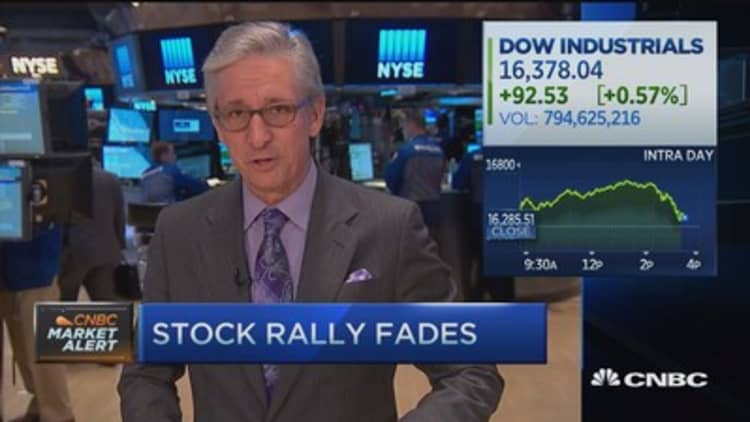
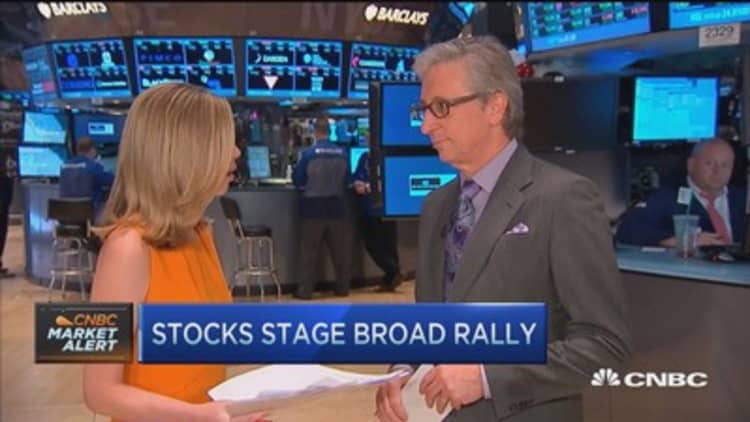
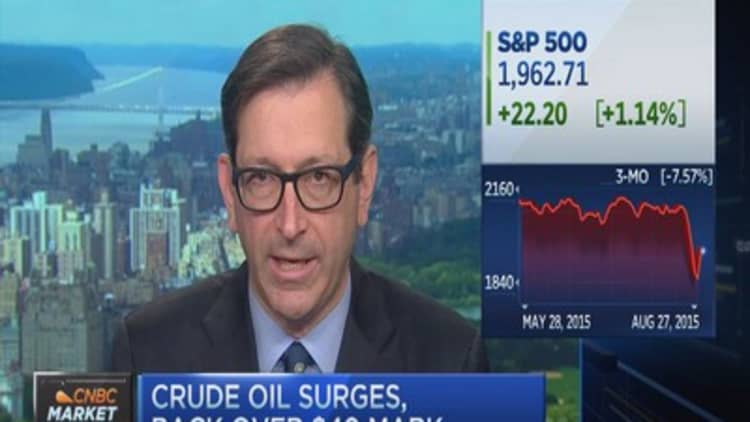
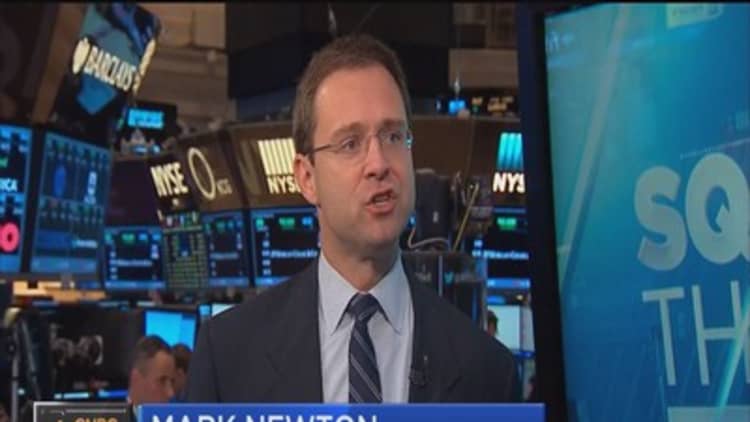
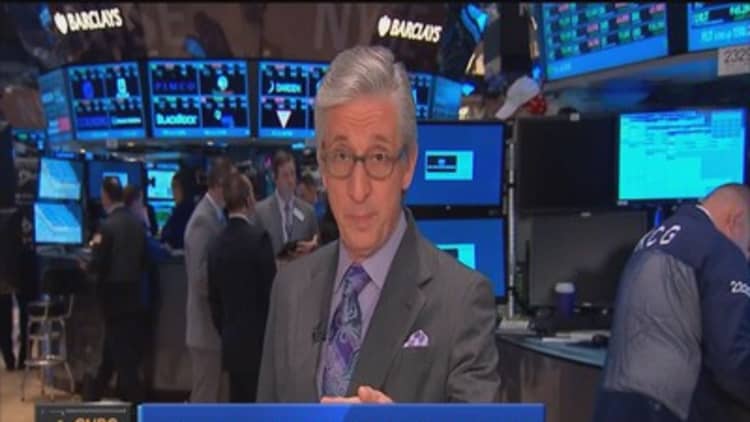
U.S. stocks closed more than 2 percent higher in a second straight day of recovery from a recent plunge, with sentiment helped by a rebound in oil and continued signs of strength in the U.S. economy.
The major averages ended near session highs after briefly more than halving gains in choppy trade leading into the close.
The Nasdaq Composite outperformed with gains of 2.45 percent to swing out of correction and into positive territory for 2015.
Read More
The Dow Jones industrial average also emerged from correction territory, closing 369 points higher after earlier adding as much as 381 points. The index briefly traded less than 100 points higher in the hour leading into the close.
"These couple days has been the bounce," said John Canally of LPL Financial. As for the intraday dip, "I think we're just getting some people hesitant to buy much further."
Intraday performance on the Dow
"No real catalysts. Lack of bids at this point," Peter Coleman, head of trading at Convergex, said of the late afternoon fade. He noted that the Dow briefly added more than 1,000 points over the last two trading sessions and people were taking profits and covering short positions.
"This isn't a one-day event," he said, noting that it will likely take two to three weeks for stocks to recover from the recent plunge.
The S&P 500 rose out of correction with Wednesday's stellar gains of about 4 percent. As of late-morning trade, no components of the index had set new 52-week highs or lows.
Crude oil was in focus after surging more than 10 percent to top $42 a barrel, with most of the gains attributed to short covering after lower-than-expected crude inventories. Futures for October delivery jumped 10.3 percent to $42.56 a barrel on the New York Mercantile Exchange for its biggest daily gain since March 2009.
Brent also surged more than 8 percent to above $46 a barrel, on track for its best day since April 2009.
"That's a big positive. That breaks the downside momentum, too," said Bruce Bittles, chief investment strategist at R.W. Baird. "If oil kept crashing that would send a terrible message for the global economy."
Energy surged 4.9 percent to lead the S&P 500, while Chevron jumping more than 6 percent as the greatest blue chip advancer.
Apple jumped nearly 3 percent. The stock remains in correction territory after closing out of a bear market on Wednesday.
"Obviously the rally is continuing this morning. It's basically strength here after the good economic news we got," said Peter Cardillo, chief market economist at Rockwell Global Capital. He said stocks have likely hit a bottom. "The China concerns are about to subside as the market concentrates on the (U.S.) economic data."
The second estimate of second-quarter GDP came in at 3.7 percent, topping the first read of an annualized 2.3 percent.
"I thought it was a very pretty number, particularly the revisions," said Marie Schofield, chief economist and senior portfolio manager at Columbia Threadneedle Investments. "The principle areas where we saw those revisions (such as final sales) were important, gives the underlying trend in demand and growth."
However, she said with the increased trade deficit and buildup in inventories she is "not as encouraged by the second half as the second quarter."
The earliest Schofield expects a rate to come is in October, with a greater probability for January.
In a sign of continued improvement in the labor market, weekly jobless claims came in slightly lower than expected at 271,000, marking the .
July pending home sales rose 0.5 percent, holding steady from an upwardly revised June reading of a 0.5 percent increase.
Bond yields trimmed gains, with the 10-year at 2.17 percent and the 2-year at 0.68 percent. Earlier, the hit 2.2 percent, its highest level since Aug. 19.
The Treasury Department's auction of $29 billion of 7-year notes at a high yield of 1.930 percent was met with slightly above-average demand.
The U.S. dollar traded mixed, weaker against emerging market currencies and stronger against the euro and yen. The euro traded near $1.12 and the yen held around 120.96 yen against the greenback.
"EM (currencies) are up today because there's been such a massive unwind in the last week or so," said Jason Leinwand, managing director of Riverside Risk Advisors. He noted positive sentiment on the U.S. economy supported the dollar against the euro and yen.
Gold futures for December delivery settled down $2.00 to $1,122.60 an ounce.
"The combination of stronger economic data from both the U.S. and Europe and more stable China and EM, combined with a somewhat more dovish Fed postponing rate hikes is definitely good news for both the U.S. and Europe," said Ilya Feygin, senior strategist at WallachBeth Capital.
"The U.S. market has already partially reacted yesterday and will open about 0.8 percent higher this morning," he said. It faces overhead resistance less than 1 percent above here and buying on the elevated opening gap has not been a good tactical buy point in this more volatile market with lower liquidity."
The major averages had their best day in four years on Wednesday. After five consecutive days of triple-digit declines, the Dow surged 619 points into Wednesday's close, finishing the day at 16,285. The S&P 500 was up nearly 73 at 1,940.5. The Nasdaq surged more than 4 percent to 4,697.
The gains supported global markets on Thursday, with the DAX and STOXX Europe 600 both surging more than 3 percent and China's Shanghai Composite index closing up 5.4 percent to reclaim the critical 3,000 mark. The Nikkei and Hang Seng closed up 1.08 and 3.60 percent, respectively.
The positive close in China was the first in five trading sessions, after improved sentiment in the U.S. managed to outweigh the fears surrounding China's slowing economy, which has been partly responsible for the recent selloff seen in global stocks.
As of the U.S. close on Wednesday, losses on the S&P Global BMI totaled $3.45 trillion, according to Howard Silverblatt of S&P Dow Jones Indices.
Read MoreStocks are ready for more rock and roll
However, many analysts cautioned the selloff could have further to go despite the near-term rally.
In a note late Wednesday, S&P Capital IQ's Sam Stovall said, "The S&P 500 breached critical support at 2034 and let loose to the downside. This move leaves a formidable zone of resistance at the high-volume area of 2092-2115 that has been building since March. According to i10Research, there is no reason to turn bullish until this zone is eclipsed."
The CBOE Volatility Index, widely considered the best gauge of fear in the market, traded near 26.
After spiking above 50 on Monday, the VIX closed near 30 on Wednesday, still far above the 20 level that most analysts would be more comfortable with.
"The VIX at 30 with a rally like that (Wednesday) is pretty surprising. To me with the VIX at 30 shows there's still a lot of uncertainty out there," said Randy Frederick, managing director of trading and derivatives at Charles Schwab.
Investors also eyed a key meeting of central bankers at Jackson Hole, Wyoming. The annual Economic Policy Symposium started on Thursday and brought together academics, financial market participants and many of the world's leading central bankers.
The event will be scrutinized for signals on near-term monetary policy action in the United States, although many policymakers including U.S. Federal Chair Janet Yellen and Daniel Tarullo, a member of the Fed's Board of Governors, are not attending.
Read MoreWhy is Janet Yellen skipping Jackson Hole?
Federal Reserve Bank of Kansas City President Esther George said in a CNBC interview from Jackson Hole that the central bank should normalize interest rates, a view the non-voting Fed member has consistently held. She added it's important for the Fed to understand the extreme volatility in stock markets this week, but cautioned that markets are focused on the near term.
On Thursday, New York Fed President William Dudley said the case for a U.S. interest rate hike in September has become less compelling. The remarks added support to gains in equities. However, he did not say September was off the table, instead adding that the Fed would review data and market conditions.
Major U.S. Indexes
Some major earnings were also due for release Thursday, including Dollar General, Tiffany and Signet Jewelers before market open. Autodesk, GameStop, Smith & Wesson and Splunk are due after the bell.
Tiffany closed down 2.1 percent after earning an adjusted 86 cents per share for its latest quarter, missing estimates by 5 cents. Revenue was also below forecasts, with the luxury goods retailer pointing to the negative effects of a strong dollar and challenging economic conditions in certain markets.
Read MoreEarly movers: TIF, SJM, DG, MIK, CSX, TSLA, STJ, GES, PVH & more
Dollar General jumped about 3.2 percent after the firm beat estimates by 1 cent with quarterly profit of 95 cents per share, though revenue was slightly below forecasts. The discount retailer said both customer traffic and average purchases grew during the quarter.
The Dow Jones Industrial Average closed up 369.26 points, or 2.27 percent, at 16,654.77, with Chevron leading all blue chips higher.
The closed up 47.15 points, or 2.43 percent, at 1,987.66, with energy surging 4.9 percent to lead all 10 sectors higher..
The Nasdaq closed up 115.17 points, or 2.45 percent, at 4,812.71.
About seven stocks advanced for every decliner on the New York Stock Exchange, with an exchange volume of nearly 1.3 million and a composite volume of nearly 4.9 billion in the close.
The afternoon issues with data display on the exchange, a "cosmetic problem", did not seem to affect trading.
—CNBC's Peter Schacknow contributed to this report.
On tap this week:
Thursday
Jackson Hole Fed symposium begins
Friday
8:30 a.m.: Personal income
10 a.m.: Consumer sentiment
Saturday
12:25 p.m.: Fed Vice Chairman Stanley Fischer at Jackson Hole; topic U.S. inflation
More From CNBC.com:



